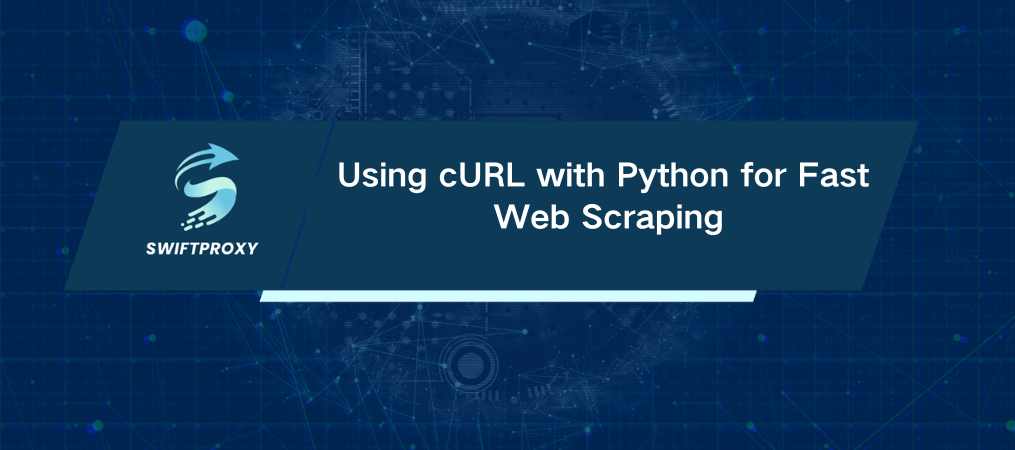Using cURL with Python for Fast Web Scraping

Web scraping is more than just a buzzword—it's a game-changer. Whether you're pulling data for analysis, research, or automating tasks, getting the right tools in place is key. Python offers a rich set of libraries to help you interact with websites, but have you considered using cURL via PycURL? It's fast, powerful, and in many cases, more efficient than other libraries. Let's break down how to harness the power of cURL for web scraping in Python, and see why it's worth your attention.
Why cURL
You might already know that Python has libraries like Requests and HTTPX for handling HTTP requests. So why choose PycURL? The answer lies in its raw performance and fine-grained control. PycURL leverages the speed and flexibility of the cURL tool, making it an excellent choice for handling complex HTTP requests at scale. But don't take our word for it—let's dive in and show you how to get started.
Setting Up PycURL in Python
Before we get into the nitty-gritty, you need to install PycURL. It's straightforward:
pip install pycurl
This step is a breeze, but it opens the door to a powerful toolkit for web scraping.
Making First HTTP Request with PycURL
Now, let's get to the good stuff. Here's how you can make a simple GET request to fetch data from a URL using PycURL:
import pycurl
import certifi
from io import BytesIO
buffer = BytesIO() # Buffer to store the response
c = pycurl.Curl() # Initialize cURL object
c.setopt(c.URL, 'https://httpbin.org/get') # Set the URL
c.setopt(c.WRITEDATA, buffer) # Capture the response in the buffer
c.setopt(c.CAINFO, certifi.where()) # Secure SSL/TLS verification
c.perform() # Perform the request
c.close() # Close the cURL object to free up resources
# Print the response
response = buffer.getvalue().decode('iso-8859-1')
print(response)
Notice how clean and concise this is. PycURL gives you deep control over the request process, making it easy to tweak settings like SSL verification and custom headers.
Handling POST Requests and Sending Data Properly
Sometimes, you need to send data with your requests. Whether it's a form submission or JSON payload, PycURL makes this easy.
Here's an example of sending a POST request:
import pycurl
import certifi
from io import BytesIO
buffer = BytesIO()
c = pycurl.Curl()
c.setopt(c.URL, 'https://httpbin.org/post') # POST request URL
data = 'param1="pycurl"¶m2="scraping"'
c.setopt(c.POSTFIELDS, data) # Set the POST data
c.setopt(c.WRITEDATA, buffer) # Capture response
c.setopt(c.CAINFO, certifi.where()) # Secure SSL verification
c.perform()
c.close()
response = buffer.getvalue().decode('iso-8859-1')
print(response)
Here's the key: PycURL lets you handle more than just basic GET requests. You can effortlessly manage POST requests and send custom data as needed.
Adding Custom Headers to Your Requests
In many scenarios, you'll need to pass custom headers—whether for authentication, content type, or other purposes. PycURL allows you to set custom HTTP headers effortlessly:
import pycurl
import certifi
from io import BytesIO
buffer = BytesIO()
c = pycurl.Curl()
c.setopt(c.URL, 'https://httpbin.org/get')
c.setopt(c.HTTPHEADER, ['User-Agent: MyApp', 'Accept: application/json']) # Custom headers
c.setopt(c.WRITEDATA, buffer)
c.setopt(c.CAINFO, certifi.where())
c.perform()
c.close()
response = buffer.getvalue().decode('iso-8859-1')
print(response)
This is crucial when working with APIs or handling sessions that require specific header values.
Handling Different Content Types
Let's say you're working with an API that returns XML or JSON. PycURL makes it simple to handle different types of responses. Here's how you can process an XML response:
import pycurl
import certifi
from io import BytesIO
import xml.etree.ElementTree as ET
buffer = BytesIO()
c = pycurl.Curl()
c.setopt(c.URL, 'https://www.google.com/sitemap.xml')
c.setopt(c.WRITEDATA, buffer)
c.setopt(c.CAINFO, certifi.where())
c.perform()
c.close()
# Parse the XML response
body = buffer.getvalue()
root = ET.fromstring(body.decode('utf-8'))
print(f"Root tag: {root.tag}, Attributes: {root.attrib}")
Handling XML data in Python doesn't need to be complex. PycURL, combined with libraries like xml.etree.ElementTree, makes parsing seamless.
Dealing with Errors
One of the hallmarks of a reliable web scraper is good error handling. PycURL lets you catch and manage errors in a clean way:
import pycurl
import certifi
from io import BytesIO
c = pycurl.Curl()
buffer = BytesIO()
c.setopt(c.URL, 'http://example.com')
c.setopt(c.WRITEDATA, buffer)
c.setopt(c.CAINFO, certifi.where())
try:
c.perform()
except pycurl.error as e:
errno, errstr = e.args
print(f"Error: {errstr} (errno {errno})")
finally:
c.close()
body = buffer.getvalue()
print(body.decode('iso-8859-1'))
The try-except block ensures that even when things go wrong, you can gracefully handle errors and troubleshoot quickly.
Advanced cURL Features: Cookies, Timeouts, and More
For advanced users, PycURL supports powerful features like handling cookies, setting timeouts, and more. Here's a quick look at using cookies and setting a timeout:
import pycurl
import certifi
from io import BytesIO
buffer = BytesIO()
c = pycurl.Curl()
c.setopt(c.URL, 'http://httpbin.org/cookies')
c.setopt(c.COOKIE, 'user=pycurl') # Set cookie
c.setopt(c.TIMEOUT, 30) # Timeout after 30 seconds
c.setopt(c.WRITEDATA, buffer)
c.setopt(c.CAINFO, certifi.where())
c.perform()
c.close()
response = buffer.getvalue().decode('utf-8')
print(response)
These advanced options make PycURL a flexible tool, capable of handling nearly any scraping scenario.
Choosing the Right Library for Your Project
Not all libraries are created equal, and choosing the right one for your project depends on your specific needs.
PycURL offers high performance and extensive protocol support. However, it has a moderate learning curve and lacks asynchronous support. It is best suited for advanced users who need fine-grained management of requests.
For those looking for simplicity, Requests is very easy to use. Its performance is moderate, and it supports only HTTP/HTTPS. Requests is ideal for straightforward tasks where ease of use is a priority.
If you need high performance with asynchronous support, both HTTPX and AIOHTTP are solid choices. HTTPX supports HTTP/HTTPS, HTTP/2, and WebSockets, while AIOHTTP supports HTTP/HTTPS and WebSockets. These libraries are great for building asynchronous scrapers.
Conclusion
Using cURL with Python via PycURL offers powerful performance and control for web scraping. It excels in handling complex requests, managing cookies, and setting custom headers. Though it has a steeper learning curve than simpler libraries like Requests, its flexibility makes it ideal for advanced scraping needs. Mastering cURL with Python can greatly enhance your scraping capabilities.

















































